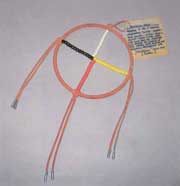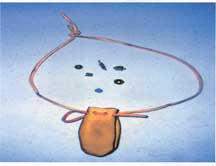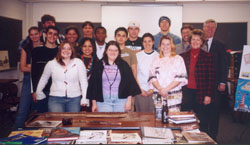
Home
- Artifacts
- Buildings & Businesses
- Churches
- Holidays & Celebrations
- Counties/Locations
- Delta College
- Early Settlers
- Ethnic Background
- Local, Michigan, U.S. and World Events
- Family Genealogy
- Farming
- Libraries & Museums
- Local Sites
- Logging
- Musicians, Artists & Famous People
- Nature, Weather & Four Seasons
- Railroads
- Schools
- Sports

Medicine Wheel
Squires Family Reunion
For as long as I can remember it has been a custom for my family to attend our family reunion on the second Sunday of August at Wilson State Park in Harrison, Michigan. It is a pleasant sight to see everyone huddled under the pavilion deep in conversation with each other. My Aunt Esther plays a rather large role at the reunion, as she sits at the picnic table with all the little children surrounding her, discussing the history of the Chippewa. She reads them stories and makes them gifts that relate to Indian heritage. This year Aunt Esther made the children medicine bags containing a heart, which means love (zaa-gi-wiin)- to know love is to know peace, a bead that means power, a silver feather, two healing stones, and a bell that wards off dangerous creatures. She teaches Indian language and crafts out of Warren, Michigan . I am delighted to say that she is very proud of our heritage. Cousin Joe also sits at the picnic table, posing for pictures with whoever wants one taken. He dresses in full suit and headdress posing with his peace pipe, which is usually held by the elders who lead at the spiritual gatherings.
Everyone who attends the family reunion brings a dish of food and a new recipe to add to our Elders Family Recipe Book that has been around for many years. There are several recipes from the elders, dating back to as early as 1930. Some of the women participate in the tribal ceremony; they make a handmade craft pertaining to Indian folklore and bring it to exchange. The Squires family reunion is very special to everyone as it keeps our Indian heritage alive and strong.
It is important to keep our culture triumphant from generation to generation, for we are very proud of our heritage. However, it has not been the same since my grandma Merle Squires/Popour passed away. She was around three quarters Indian and married a man of French descent who settled in Canada. This is where the Popour name, which is where my maiden name originated.My Family History
According to my cousin, Pearl Carr-Squires, "My Indian history began with Sir. Charles Hamelin Sr., a well educated man who came from Hamelin Germany, in 1670. He eventually came to be in Montreal, Canada and then settled in Michelimackinaw, Michigan. This is where he met and married Catherine, a female savage of the Sauteaux Tribe, daughter of a Pagan Savage named Mounc. We are descendents of the Chippewa Tribe who have been identified in the Upper Great Lakes region for four hundred and fifty years. A prime fishing and hunting location near Sault Ste. Marie, Michigan, became our permanent settlement." I am presently waiting for my enrollment form from the Sault Ste. Marie Tribe of Chippewa Indians, so I can become a tribal member (have been unable to enroll for several years due to unopened enrollment.)
Life of the Indians
The Indians traveled by foot most of the time, always in single file with the women trailing behind. Michigan Indians only wore three feathers in their hair, rather than the feather bonnets you see in movies today. They used canoes to travel up stream and into the Great Lakes. Fishing was an important way of life for the Indians and a major part of their diet. The fish were caught with nets that fastened to the end of poles. The Indians also ate wild rice and berries as a part of their regimen. They lived in tepees and lodges that were made from frames covered with strips of bark that were sewn together by the women (Carr).
Chippewa Religion
The religion and beliefs of the Chippewa tribes were that of the Manitou, which they identified as their god. They felt they shared the earth with all animate and inanimate objects, so they respected all objects as if they had a soul. The Indians did not have a church to call upon their god. They had certain areas they considered to be sacred to them. They would take beads or tobacco (semah) down by a river or a stream and place them by a rock as a gift for the spirits. When the Chippewa boy hit puberty he would be sent to an isolated place where a vision was sought through fasting. At this time a spirit was called and would remain his lifelong guardian. The Chippewa religion was practiced to ward off evil and to come into contact with spirits, which would guide and protect them (Carr).
Chippewa Ceremonies
 |
Ceremonies are sacred rituals which the Indians would attend to cleanse themselves with sacred medicines along with communicating amongst each other. An extremely important part of the ceremonies are that of offering tobacco. As soon as the tobacco exchanged hands the ceremony began. The ones who performed the ceremonies are the elders, pipe carriers, drum keepers, and the lodge conductors. At the ceremonies small portions of food are thrown into the sacred fire, or to the mother earth, before the feast began. There are several reasons for these ceremonies, some included burial, changing of seasons, marriage, naming, pipe smoking, and presenting one with an eagle feather. These ceremonies do still take place today ("Sault Ste. Marie").
Treatment of the Native Americans
It saddens me to think about how the Indians were treated many years ago. Even though they fought for their land and didn't surrender easily, they were still overpowered by the white people and the U.S. government. They signed treaties not knowing what they were signing (only what was told to them by the government), which resulted in losing the titles to their land and being locked up on reservations unable to hunt and fish. They had to rely on the government for food or they would starve. They lost their religion and were forced into Christianity. Furthermore, they were made to live the American way and to learn the English language and their culture was ripped away from them, leaving them with shattered spirits and forcing some to turn to liquor and become failures (Michels).
The Signing of the Treaty
In the 1970's our government established reservation lands in the eastern Upper Peninsula; which developed programs to meet the essential housing, education, and health needs of our membership. In 1975 the tribal name became Sault Ste. Marie Tribe of Chippewa Indians. Our family is extremely pleased to say that after numerous years of fighting, in December of 1997, the Million Land Claims Settlement was signed into law by President Clinton for the lands that were lost. Every year a percentage of the interest of the monies is given to the elders (age 60 and older) along with continued education and bettering our tribal finances. If only my ancestors were here to see this, their self-esteem would soar!
 Learning all of this it has really captured my heart and made me realize how special our heritage is to me. This is one important reason for me to continue going to our reunions and carry on learning about my family customs.
Learning all of this it has really captured my heart and made me realize how special our heritage is to me. This is one important reason for me to continue going to our reunions and carry on learning about my family customs.
Photo: Melissa Griffiths and English 111A English students present their Michigan research topics to guests Kelly Schwarz, Hoyt Librarian; Prof. Larry Levy, English Division Chair; former Delta College President Peter Boyse; and Prof. Mary Beth Looby. Melissa (front right) wears the "Jingle Dress," part of the Historical Players collection of regalia and costumes.
Works Cited
- Carr - Squires, Pearl. Letter to the author. 23 Feb. 1999.
- Michels, Patricia J. Telephone interview. 30 Nov. 2004.
- ---. Personal interview. 4 Dec. 2004.
- "Sault Ste. Marie Tribe of Chippewa Indians." Saulttribe.com. The Sacred Ceremonies. 4 Dec. 2004 <http://www.saulttribe.org/ceremonies.htm>.
| The written and visual works in Mid-Michigan Remembers-Stories about Us were chosen on the basis of their quality, diversity, community interest and appeal. Views expressed do not necessarily reflect those of the College. This space is provided as a service by Delta College. |